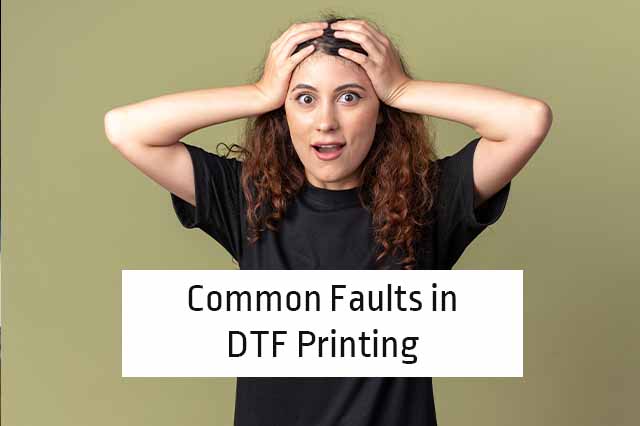What is DTF Printing on Shirts?
DTF printing, also known as Direct To Film printing, is a technique used to transfer designs onto garments such as t-shirts. It involves printing the design directly onto a film and then using heat to transfer the design onto the garment. This method of printing has become increasingly popular in recent years due to its cost-effectiveness and ease of use.
Common Faults in DTF Printing
Poor Quality Prints
What could be the problem? Poor quality prints can occur when the temperature or pressure settings are incorrect during the transfer process.
What causes the fault? The incorrect settings can cause the ink to not adhere properly to the garment or for it to be transferred unevenly.
How can the fault be fixed? To fix this issue, make sure that you are using the correct temperature and pressure settings for your particular type of garment. Additionally, make sure that you are using a high-quality film that is compatible with your printer and that it has been stored correctly prior to use.
Color Bleeding
What could be the problem? Color bleeding occurs when colors from one part of an image bleed into another part of an image due to incorrect settings or poor quality materials being used during the transfer process.
What causes the fault? Incorrect settings such as too high temperatures or too much pressure can cause colors to bleed into each other while transferring from film onto fabric. Poor quality materials such as low-grade films can also cause color bleeding due to their inability to withstand high temperatures and pressures during transfer processes.
How can the fault be fixed? To fix this issue, make sure that you are using a high-quality film that is compatible with your printer and that it has been stored correctly prior to use. Additionally, adjust your temperature and pressure settings accordingly so that they are appropriate for your particular type of garment.
Cracking or Peeling After Washing
What could be the problem? Cracking or peeling after washing occurs when there is insufficient adhesion between ink and fabric due to incorrect settings or poor quality materials being used during transfer processes.
What causes the fault? Insufficient adhesion between ink and fabric can occur if either too low temperatures or too little pressure were used during transfer processes, resulting in inadequate bonding between ink and fabric fibers which will lead to cracking or peeling after washing cycles have been completed. Additionally, poor quality materials such as low-grade films may not have enough adhesive properties which will result in cracking or peeling after washing cycles have been completed.
How can the fault be fixed? To fix this issue, make sure that you are using a high-quality film that is compatible with your printer and that it has been stored correctly prior to use. Additionally, adjust your temperature and pressure settings accordingly so that they are appropriate for your particular type of garment in order ensure maximum adhesion between ink and fabric fibers before washing cycles begin.
| Solution | Cause | Problem | Fault |
| Adjust temperature/pressure settings/use high-quality film | Incorrect temperature/pressure settings/low-grade film used | Ink does not adhere properly/unevenly transferred | Poor Quality Prints |
| Adjust temperature/pressure settings/use high-quality film | Incorrect temperature/pressure settings/low-grade film used | Colors from one part bleed into another part of image | Color Bleeding |
| Adjust temperature/pressure settings /use high-quality films | Too low temperatures/too little pressure /low grade films used | Insufficient adhesion between ink & fabric fibers | Cracking/Peeling After Washing |
Summary: Common Faults in DTF Printing
DTF printing on shirts requires careful consideration when setting up parameters such as temperature, pressure, and material selection in order for successful transfers without any faults occurring during production runs. Common faults include poor quality prints due to incorrect parameters resulting in uneven transfers; color bleeding caused by incorrect parameters leading colors from one part of an image bleeding into another; and cracking or peeling after washing caused by insufficient adhesion between ink & fabric fibers due inadequate parameters being set up prior to production runs beginning. By understanding what these common faults are caused by, users will be able to equip themselves with knowledge on how best to avoid them occurring again in future production runs.

